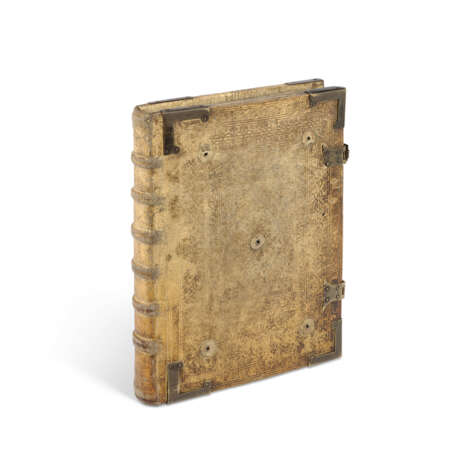ID 870793
Lot 46 | Brothers of the Fraterhaus St. Michael in Cologne
Estimate value
£ 18 000 – 25 000
Vesperale, in Latin, decorated manuscript on vellum, Cologne, Fraterhaus St Michael am Weidenbach, 1535.
A Vesperale from a series of decorated choirbooks produced by the Augustinian canons regular of St Michael am Weidenbach in Cologne and dated 1535; a hybrid manuscript modified for use within the Fraterhaus.
365 x 260mm. ii (paper) + 92 + i (paper), contemporary foliation (‘I-LXXXV’) omitting the first four vellum leaves and later foliation (‘86-88’) followed here, rubrics in red, music of hufnagel notation on five-line staves ruled in black, barlines in red, initials alternating red and blue interspersed with initials in black with penwork foliate flourishing, 7 one-line penwork-flourished or fleuronnée initials, 5 two-line fleuronnée initials in blue, red and green (marginal thumbing, especially to the earlier leaves, and some surface soiling throughout). German 17th-century stamped pigskin, metal cornerpieces (bosses missing).
Provenance:
(1) Written and decorated in the Fraterhaus St Michael am Weidenbach, Cologne; dated ‘1535’ in a black penwork initial on f.50, ?initials of certain of the brothers added to penwork initials between ff.50-69. The Augustinian canons regular of St Michael at Weidenbach were part of the Congregation of Windesheim, an offshoot of the Brethren of the Common Life that reached its apogee towards the end of the 15th century, with 102 houses across the Netherlands and the ecclesiastical province of Cologne. The Fraterhaus was founded in 1417 with statutes that made specific reference to the labour of writing, illuminating and binding manuscripts to be divided between the brothers, and the community continued producing liturgical books for their own use and for lay patrons until the beginning of the 17th century, when repeated objections from Cologne’s craftsmen and guilds finally brought an end to the participation of the brothers in the town’s book trade; the house was suppressed in 1793. A series of choirbooks produced by the brothers of St Michael between 1498 and 1553 is now held in the Cathedral libraries of Cologne (Kath. Pfarrei St. Kunibert, Cods. I-IV and Erzbischöfliche Diözesan- und Dombibliothek, Cods. 221-224, 229, 257, 274, 1172, and 1451): the black penwork-flourished initials in our manuscript – into which have been added the date of completion and the ?initials of the brothers – also appear in an Antiphonal dated 1533 (Kath. Pfarrei St. Kunibert, Cod. III). Both manuscripts are bound in pigskin with the same metal cornerpiece and clasp design.
(2) Marginal annotations and added chants in 16th- to 18th-century hands on the paper endleaves and throughout the manuscript indicate that it was in continual use by the Brothers of St Michael, presumably until the suppression of the house in 1793.
(3) Quaritch, sold June 2010 to the present owner.
Contents: Index of antiphons, arranged according to the liturgical year, following the order: Temporale, Sanctorale, Dedication of a Church, Common of Saints, ff.[1-1v, unfoliated]; Temporale, from the Ascension to the 25th Sunday after the octave of Pentecost, ff.[2-4, unfoliated] and 1-10 [contemporary foliation]; Sanctorale, from the feast of St Andrew (30 November) to the feast of St Catherine (25 November), concluding with the Dedication of a Church, ff. 10-46; Common of Saints, including apostles, martyrs, confessors, and virgins, ff.46-49v; additional feasts from the Sanctorale, with antiphons for Vespers and Lauds for feasts including St Alban, Severin of Cologne, and St Cunibert, followed by the Visitation, Nativity and Conception of Mary, ff.50-79; Suffrages, ff.79-85; added chants in later hands, ff.85-88.
Our manuscript appears to have been written in two parts by the brothers of the Fraterhaus. The first portion, ff.[1]-49v, comprises a rarer liturgical text, the Vesperale – an excerpt of the Antiphonal containing the chants sung at Vespers alone – whose Cologne use is indicated by the inclusion of locally-venerated saints such as Gereon and Elphigius (ff. 36-37) in the Sanctorale. The second portion, from f.50 onwards, represents a modification of the Vesperale for use within the Fraterhaus: antiphons for both Vespers and Lauds for the feasts of saints venerated in Cologne are found here, with special attention paid to the feast of St Alban (ff.50-56), to whom a shrine in the Romanesque church of St Pantaleon was dedicated, along with chants for the feasts of Sts Severin and Cunibert. A contemporary index of antiphons (ff.[1-1v]) attempts to re-impose the order of the liturgical year by incorporating these additional feasts into the cycle for the Sanctorale.
Special notice
No VAT on hammer price or buyer's premium.
| Place of origin: | Western Europe, Germany, Europe |
|---|---|
| Auction house category: | Medieval & renaissance manuscripts |
| Place of origin: | Western Europe, Germany, Europe |
|---|---|
| Auction house category: | Medieval & renaissance manuscripts |
| Address of auction |
CHRISTIE'S 8 King Street, St. James's SW1Y 6QT London United Kingdom | |
|---|---|---|
| Preview |
| |
| Phone | +44 (0)20 7839 9060 | |
| Buyer Premium | see on Website | |
| Conditions of purchase | Conditions of purchase |








